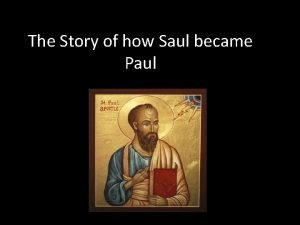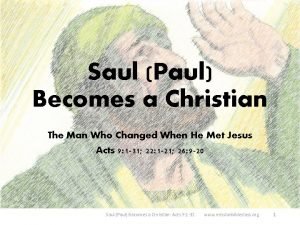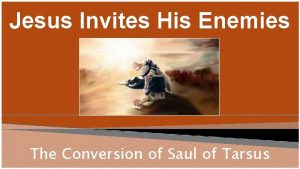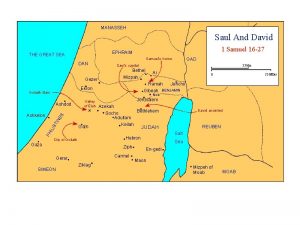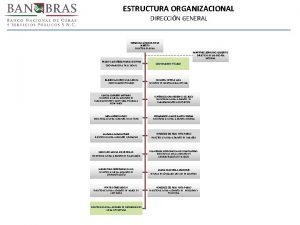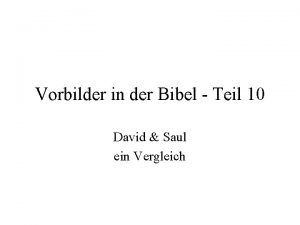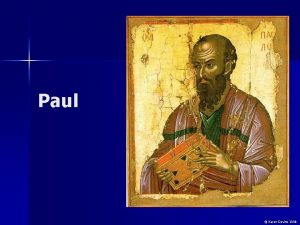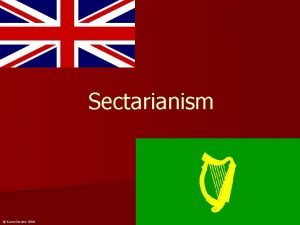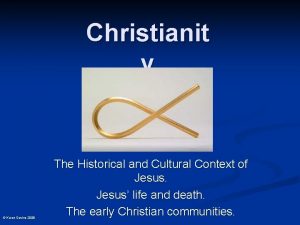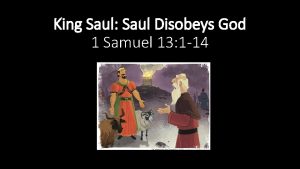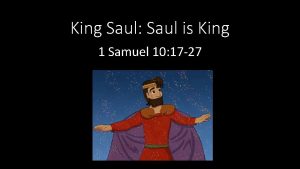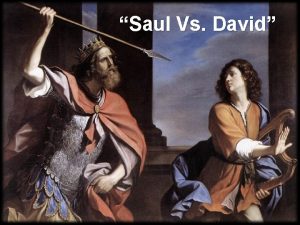Paul Karen Devine 2008 Saul n n n


















- Slides: 18

Paul © Karen Devine 2008

Saul n n n Saul was born in Tarsus circa 10 CE. It was a centre of thriving culture, philosophy and education. Saul was a Hellenistic Jew and a Roman citizen. He was a tent maker. Saul was brought up in Jerusalem and a student of Rabbi Gamaliel. He belonged to the Jewish tribe of Benjamin.

Saul’s Conversion n n He was a Pharisee and zealous for Jewish traditions. Saul was a persecutor of Christians. Saul never met Jesus, yet had a mystical conversion experience on the road to Damascus, 3 -5 years after Jesus’ death. He knew the apostle Peter and James, the brother of Jesus.

Paul’s Journeys n n Saul became Paul and a Christian missionary. His journeys, letters and preaching were integral in establishing Christianity in the Greco-Roman world. Paul’s belief that gentile Christians did not have to be circumcised or follow the Jewish law enabled a broader group of people to access Christianity. He laid down foundational beliefs about Christianity.

Paul’s Theology n a) b) c) The key aspects of Paul’s theology are: Jesus died and was resurrected. Hence, all humans will be resurrected as well through belief in Jesus Christ. Salvation is available to all humanity. The church is a body united by belief and guided by the Holy Spirit.

Paul’s Death n n Paul was executed in Rome circa 62 CE. His teachings have influenced every generation of Christian thinking.

Paul’s Contribution to Christianity n n After Jesus, Paul is the most significant figure in Christian history. He is known as an Apostle (one sent) since he had a vision of Jesus. In this sense he was an eyewitness to the resurrection. Paul’s letters constitute about 25% of the Christian Scriptures and they are the earliest Christian documents to have been preserved.

Paul and Christian Doctrine n a) b) c) As a theologian, Paul formulated Christian doctrine, for example: Salvation through Jesus Christ Atonement: ie: Jesus’ death was a sacrifice for the sins of the world. Eschatology: the end times and the dawning of a new age. (the Parousia).

Paul and Christian Doctrine n n By separating the Mosaic Law from Christianity, Paul saw that Christianity was no longer a sect of Judaism. It became a religion in its own right. Paul’s view of Christianity saw a united church of baptised followers. He saw the church as the “body of Christ”.

Paul and Christian Rituals § § a) b) c) Paul’s uniting message is inclusive of women and they played a prominent leadership role in the early Christian Church. Paul added rituals which are still used today including: Baptism - Immersion in water symbolised death in Jesus and coming out of the water symbolised resurrection. Church meetings met in honour of Jesus’ resurrection. A communal meal which Paul called “the Lord’s Supper”. It consisted of bread and wine and was in commemoration of the death of Jesus.

Paul vs Peter In the early Christian Communities most of the first Christians were Jews. n But what if a person was a gentile and wanted to be a Christian, did they have to become a Jew first? n Peter and Paul had differing opinions. n

Paul’s views n n n n One could become Christian without being a Jew first. Gentiles were not bound by the Jewish food laws. Gentiles were not bound to keep feast days. Gentile men did not have to be circumcised. Sacrifice through temple was no longer needed. Paul’s resolution of these issues effectively separated Judaism from Christianity permanently. Paul largely preached to gentiles.

Peter’s views n n n Peter, James and John were the Jerusalem “apostles” who opposed Paul on the issue of the dietary or food laws. Peter sees the necessity of keeping the Mosaic Law and achieving ethical perfection. They agreed that Gentiles did not have to be circumcised to become Christians. Jewish Christianity faded out of existence with the conquering of Jerusalem in 70 CE. Peter largely preached to Jews.

Paul’s Letters n n a) b) c) d) A collection of 13 letters attributable to Paul has been included in the Christian Scriptures. They were written before the Gospels and fall into 4 major themes: Gentiles and the law Problems of church life The imminent Parousia Letters from prison.

Paul’s Letters § § a) b) c) d) e) f) However, most scholars argue that only between 7 -10 letters were actually written by Paul. The letters considered to be authentic are: Romans Galatians 1 and 2 Corinthians 1 Thessalonians Philippians Philemon

Paul’s Letters n n The other letters are either deemed pseudonymous or are disputed. These were written by his supporters and followers in his name even after he had died. Paul’s letters addressed particular problems occurring in the new Christian communities. These communities believed they were living in the last days of the world.

Paul’s Letters • • • Paul’s letters addressed the different community needs and questions about Christian faith in a diverse society. The letters were written in Greek and encouraged people in their life and faith. They were often complex documents written in a philosophical way. The letters communicate Paul’s theology and his beliefs in Jesus. There is little reference to Jesus’ words or teachings.

Question Time n Why is Paul said to be the cofounder of Christianity?
 Saul becomes paul
Saul becomes paul Paul becomes saul
Paul becomes saul 2008 2008
2008 2008 Proficiency
Proficiency Divine source theory of language
Divine source theory of language Atribut pronominal prepozitional in genitiv
Atribut pronominal prepozitional in genitiv I hate careless people thats why i like you
I hate careless people thats why i like you Ian devine accountant
Ian devine accountant Sandler devine assessment
Sandler devine assessment Leah devine design
Leah devine design Saul envy david
Saul envy david Lessons from saul's conversion
Lessons from saul's conversion David vs saul leadership
David vs saul leadership Ziph
Ziph Alyssa rivera
Alyssa rivera Wilderness of ziph
Wilderness of ziph Jorge alberto acosta
Jorge alberto acosta Saul david solomon
Saul david solomon Saul david bibel
Saul david bibel
